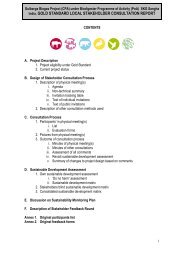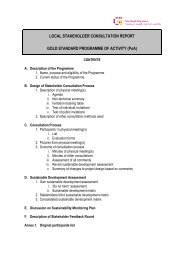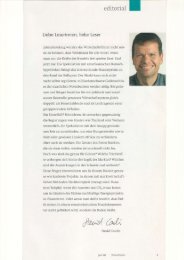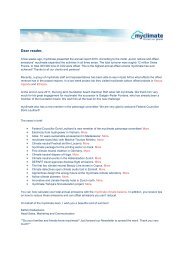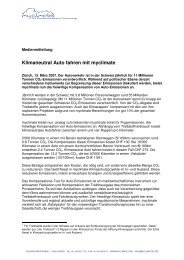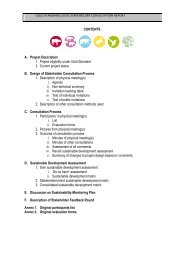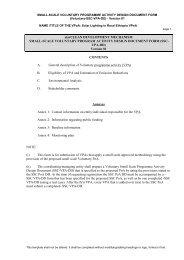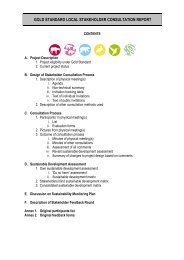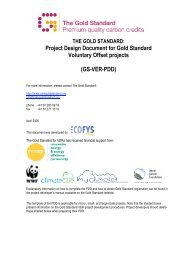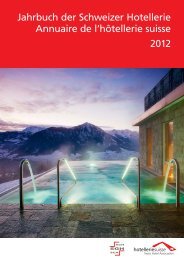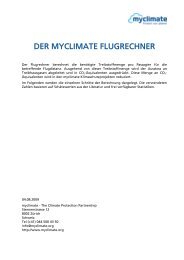Grid-connected electricity generation from wind turbines ... - MyClimate
Grid-connected electricity generation from wind turbines ... - MyClimate
Grid-connected electricity generation from wind turbines ... - MyClimate
Create successful ePaper yourself
Turn your PDF publications into a flip-book with our unique Google optimized e-Paper software.
<strong>Grid</strong>-<strong>connected</strong> <strong>electricity</strong> <strong>generation</strong> <strong>from</strong> <strong>wind</strong> <strong>turbines</strong> in Turkey<br />
Project summary<br />
With the carbon offset program “Kores Kocadağ 17.5<br />
MW Wind Power Project“, myclimate and its local<br />
partner contribute actively to climate protection,<br />
improved local air quality, livelihoods and sustainable<br />
renewable energy industry development and Turkey’s<br />
energy autonomy.<br />
The seven <strong>wind</strong> power <strong>turbines</strong> are located in the<br />
middle of the peninsula of Çeşme in the province of<br />
Izmir. Since December 2009, they deliver renewable<br />
power to about 22,000 local people of the Izmir province.<br />
Project summary<br />
The program has lead to a reduction of CO2 while<br />
making a contribution to sustainable development in<br />
the region:<br />
– Reduction of greenhouse gas emissions and<br />
diversification of Turkey’s <strong>electricity</strong> <strong>generation</strong><br />
mix.<br />
– Stimulation of the <strong>wind</strong> power industry locally and<br />
nationally, especially of larger grid <strong>connected</strong> <strong>wind</strong><br />
farms.<br />
– Recovery of non-renewable resources.<br />
– Overall reduction of pollutants resulting <strong>from</strong><br />
business-as-usual power <strong>generation</strong> industry.<br />
– Creation of local employment during the construction<br />
and the operation phase of the <strong>wind</strong> farm.<br />
– Reduction of Turkey’s increasing power import<br />
dependency.<br />
www.myclimate.org/carbon-offset-projects<br />
1<br />
Beyond Carbon Turkey, 2012
Facts and figures on the carbon offset project<br />
Project location Turkey, province of Izmir, peninsula of Çesme<br />
Project name Kores Kocadağ 17.5 MW Wind Power Project<br />
Project standard Gold Standard VER<br />
Project type Wind<br />
Emission reductions 268,564 t CO2e (over 7 years)<br />
Situation without project Regional fuel mix<br />
Project start December 2009<br />
The project country<br />
Turkey is a large, middle-income country with relatively<br />
few natural resources. The country’s main environmental<br />
issues are water pollution <strong>from</strong> the dumping of<br />
chemicals and detergents, air pollution in urban areas<br />
and the potential for spills <strong>from</strong> the 5,000 oil- and<br />
gas-carrying ships passing through the Bosporus<br />
annually. Another main issue to focus on is land<br />
degradation which is a critical agricultural problem,<br />
caused by inappropriate use of agricultural land and<br />
deforestation. Consequently, serious soil erosion has<br />
occurred in nearly 70 per cent of Turkey’s land surface.<br />
Actually, Turkey’s economy experiences a transition<br />
<strong>from</strong> a high degree of self-reliance on agriculture and<br />
heavy industry to a more diversified economy. Turkey,<br />
with its young population and growing energy<br />
demand per person, its fast growing urbanization, and<br />
its economic development, has been one of the fast<br />
growing power markets worldwide for the last two<br />
decades. Renewable energy development is making<br />
good progress in Turkey. However, investments into<br />
<strong>wind</strong> power plants in Turkey still means taking high<br />
risks, as experience is sparse and attractive financial<br />
incentives for <strong>electricity</strong> <strong>generation</strong> <strong>from</strong> renewable<br />
sources are lacking. Hence, most of the energy still<br />
derives <strong>from</strong> fossil fuels. For this reason, the project<br />
will help Turkey to stimulate and commercialise the use<br />
of grid <strong>connected</strong> renewable energy technologies and<br />
markets.<br />
Map of Turkey: The red circle shows the project region.<br />
Indicator Turkey Switzerland<br />
Total area (in km2 ) 783,562 41,285<br />
Population 79,749,461 7,870,134<br />
GDP in USD per capita (2011) 14,600 USD 47,817 USD<br />
Share of population living below the national poverty lines (2010) 16.9 % 6.9 %<br />
Energy use per capita (kg of oil, 2010) 1,441 kg 3,361 kg<br />
CO2-emissions per capita (2008) 4.0 t 5.3 t<br />
Istanbul Zurich<br />
Min. working time to buy 1 kg of rice in min 43 9<br />
Min. working time to buy 1 kg of bread in min 12 12<br />
Turkey vs. Switzerland. (Source: CIA – The World Factbook, www.cia.gov/library/publications/the-world-factbook; World Development Indicators, web.worldbank.org;<br />
Bundesamt für Statistik [2010])<br />
www.myclimate.org/carbon-offset-projects<br />
2
The situation in the project region<br />
Çeşme is the center-town of the Izmir Province, counting<br />
around 40,000 inhabitants. The name Çeşme meaning<br />
fountain probably derives <strong>from</strong> the many Ottoman<br />
fountains scattered across the city. The Izmir Province is<br />
located in western Anatolia on the Aegean coast. The<br />
province’s traditional export products such as cotton,<br />
tobacco, grapes, figs and olives have been replaced by<br />
electronics, chemicals, beverages and automotives in<br />
terms of volume of trade and thanks to industrialisation.<br />
Nevertheless, the province is still one of the most<br />
important regions in terms of food and agricultural<br />
products, ranking second after Konya in terms of<br />
agricultural production value. Besides export production,<br />
Izmir is one of the most popular tourism destinations<br />
of Turkey for domestic and foreign tourism.<br />
As mentioned before, investments into <strong>wind</strong> <strong>turbines</strong><br />
still means taking high risks due to the intermittent<br />
nature of <strong>wind</strong>. However, on the peninsula of Cesme the<br />
risk is acceptable as there is a lot of <strong>wind</strong> and the villages<br />
are spread wide apart.<br />
How the project is implemented<br />
The license for the 15 MW <strong>wind</strong> power plants was<br />
issued to the project owner Kores in June 2006. The six<br />
first <strong>turbines</strong> have been in operation since December<br />
2009.<br />
In order to inform the local stakeholders as well<br />
as guarantee their acceptance and support for the<br />
project and to comply with the Gold Standard VER<br />
(Voluntary Emission Reduction), a local stakeholder<br />
meeting was held in September 2008. At this meeting,<br />
the public and the local stakeholders were informed<br />
about the project. Particularly sensitive indicators were<br />
not identified and stakeholders have raised no concerns.<br />
When asked at the stakeholder meeting, what<br />
they like about the project, a local said: “I like that it is<br />
renewable energy and the decreasing external dependency.“<br />
Mehmet Kutluay, another local, said: „I like its<br />
benefits to nature and it creates employment. There<br />
should be more such projects.“<br />
The power plant<br />
The <strong>wind</strong> power plant consists of seven <strong>wind</strong> <strong>turbines</strong><br />
Nordex N90 of the 2.5 MW output, 90 metres diameter<br />
and a hub height of 80 metres. The <strong>wind</strong> <strong>turbines</strong> are<br />
<strong>connected</strong> to the <strong>wind</strong> farm substation through 34.5<br />
kV underground cables. The voltage is raised to 154<br />
kV, transferred to the Electricity Transformer Station<br />
and then fed into the national power grid. The power<br />
plant produces around 56,000 MWh of electric power<br />
annually what leads to annual emission reductions of<br />
Two of the seven <strong>turbines</strong><br />
Subject for postcards: the <strong>turbines</strong> by night.<br />
The hub height is 80 metres, the diameter 90 metres.<br />
The <strong>electricity</strong> transformer station<br />
“Kores Kocadağ <strong>wind</strong> plant”. The generated <strong>electricity</strong> is fed into the national<br />
power grid.<br />
about 36,000 tons of CO2. www.myclimate.org/carbon-offset-projects<br />
3
The information center<br />
To meet the requirements of the Gold Standard, an<br />
information centre out the <strong>wind</strong> power plant was<br />
built to inform people about the plant and to sensitise<br />
about climate change. Mostly pupils and students, but<br />
also members of civil associations and journalists <strong>from</strong><br />
media companies have been visiting the centre so far.<br />
A guide explains the mechanism of the <strong>wind</strong> <strong>turbines</strong><br />
first in a conference room before they are shown<br />
around at the plant. At the end, the visitors can write<br />
their opinions and comments on forms, which are<br />
hung afterwards on a board.<br />
Environmental aspects<br />
Projects under the Gold Standard scheme, as compared<br />
to other schemes, have to fulfil strict criteria regarding<br />
the involvement of stakeholders into the project<br />
development process and on the documentation of<br />
environmental and socio-economic impacts.<br />
All potential environmental issues were discussed in<br />
detail on the stakeholder consultation in September<br />
2008. The evaluation of environmental indicators<br />
regarding the project is based on the Sustainable<br />
Development Assessment Matrix provided in the Local<br />
Stakeholder Consultation Report as well as on common<br />
sense regarding the <strong>wind</strong> power plant technology. No<br />
negative or critical indicators were identified.<br />
Besides a reduction of greenhouse gases, all other air<br />
pollutants such as SOx or NOx, particles and volatile<br />
organic compounds are avoided thanks to the <strong>wind</strong><br />
power plants. The project leads neither to any significant<br />
changes nor to harmful consequences on<br />
water quality and soil condition in the project area.<br />
All bushes and trees cut were replaced by the Forestry<br />
Directorate and financed by the project partner, and<br />
routes of access were changed to minimise the number<br />
of trees which had to be cut down. The excavated<br />
waste during the construction phase was used to reorganize<br />
the area and for landscaping work.<br />
A concern often mentioned in relation with <strong>wind</strong><br />
power plants is the noise caused by the <strong>turbines</strong>. Since<br />
the noise of the seven <strong>turbines</strong>’ rotation cannot be<br />
heard further than 200 metres to the <strong>turbines</strong> and the<br />
closest settlements (Birgi and Zeytinler Villages) are<br />
located 3.5 kilometres <strong>from</strong> the power plant, nobody is<br />
affected in any way by the noise of the <strong>turbines</strong>.<br />
There isn’t any endangered flora in project area. The<br />
immigration line of birds – an often heard concern<br />
regarding <strong>wind</strong> projects – is not influenced by the<br />
<strong>wind</strong> farm.<br />
Pupils arriving at the information centre.<br />
On top of the platform, it is mostly very <strong>wind</strong>y.<br />
Pupils listening to a presentation.<br />
The <strong>wind</strong> <strong>turbines</strong> are 80 metres high.<br />
Students <strong>from</strong> the Anatolian High School in Urla have commented on what they<br />
have seen and heard.<br />
www.myclimate.org/carbon-offset-projects<br />
4
Socio-economic aspects<br />
As mentioned earlier, Turkey still has a high potential<br />
for investments into <strong>wind</strong> power plants. With this<br />
project, another step is taken towards the designation<br />
and production of renewable energy technologies<br />
in Turkey. Accordingly, it is one of the main goals to<br />
encourage entrepreneurs to invest in <strong>wind</strong> power and<br />
to provide infrastructural investments in the areas<br />
around the project site.<br />
Subsequently, the creation of employment is an<br />
important part of the project. To achieve this goal,<br />
materials for the foundations, cables and other<br />
auxiliary equipment is sourced locally, whenever<br />
possible. As local employment is cheaper and more<br />
sustainable than moving or sending their maintenance<br />
workers to Cesme, local workforce is preferred.<br />
“The project created part and full time jobs during<br />
both the construction and the operation phases”,<br />
says A. Emre Samsun, Investment Coordinator of the<br />
project partner. “Currently two persons <strong>from</strong> the<br />
neighbouring villages work as a security staff at the<br />
plant <strong>from</strong> 8.00 to 18.00. They spend most of their<br />
time patrolling through the park and also in the watch<br />
box at the entrance of the park.”<br />
Health and Safety as well as operation and<br />
maintenance trainings were held to guarantee<br />
the employee’s own security as well as correct<br />
maintenance of the plant.<br />
Monitoring<br />
The Clean Development Mechanism (CDM) baseline<br />
and monitoring methodology of the UNFCCC<br />
guarantees the external monitoring. According to<br />
the CDM, the project activity satisfies the qualifying<br />
criteria for Renewable Energy Projects and <strong>Grid</strong><br />
<strong>connected</strong> renewable <strong>electricity</strong> <strong>generation</strong>. Hence,<br />
the choice of project category and methodology is<br />
justified.<br />
Furthermore, the Gold Standard requires that<br />
indicators are included into the monitoring plan<br />
that are either crucial for an overall positive impact<br />
on sustainable development or particularly sensitive<br />
to changes in the framework conditions or where<br />
the public consultation has yielded concerns of<br />
stakeholders. The project’s positive impact on<br />
sustainable development is the reduction of<br />
greenhouse gas emissions <strong>from</strong> <strong>electricity</strong> <strong>generation</strong><br />
and the implementation of the environmental sound<br />
technology in Turkey.<br />
For further information please contact:<br />
myclimate – The Climate Protection Partnership<br />
Sternenstrasse 12<br />
CH-8002 Zurich<br />
Switzerland<br />
www.myclimate.org<br />
info@myclimate.org<br />
Tel: +41 (0) 44 500 43 50<br />
Fax: +41 (0) 44 400 43 51<br />
www.myclimate.org/carbon-offset-projects<br />
5



